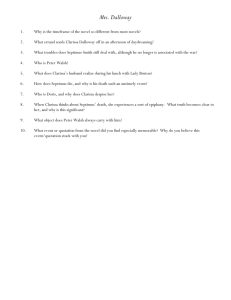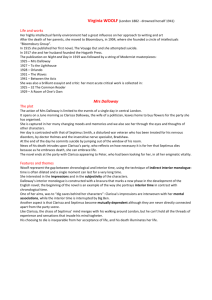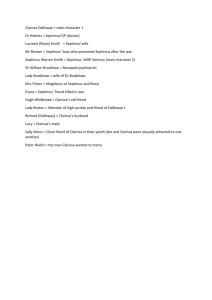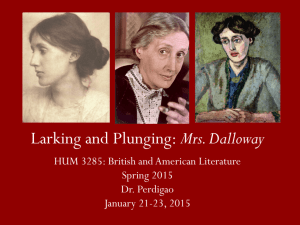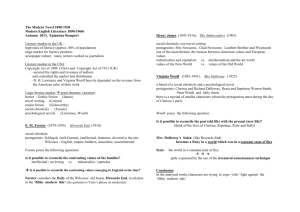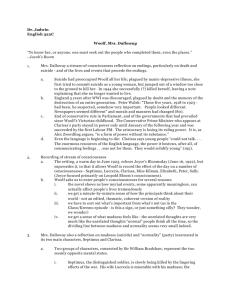A Web of Connections
advertisement
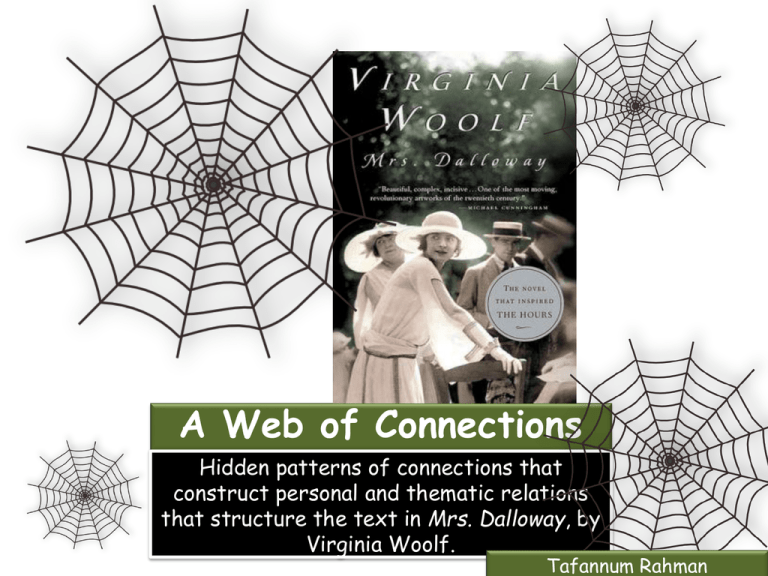
A Web of Connections Hidden patterns of connections that construct personal and thematic relations that structure the text in Mrs. Dalloway, by Virginia Woolf. Tafannum Rahman “Behind the cotton wool [of daily life] is hidden a pattern; that we—I mean all human beings—are connected with this; that the whole world is a work of art; that we are parts of the work of art. Hamlet or a Beethoven quartet is the truth about this vast mass that we call the world. But there is no Shakespeare, there is no Beethoven; certainly and emphatically there is no God; we are the words; we are the music; we are the thing itself.” ― Virginia Woolf, A Sketch of the Past Connections Between Characters There is a disconnect between people in the modern urban setting of London in Mrs. Dalloway. Woolf believes a complex web exists behind the “cotton wool” of everyday life, and she uses this web to make natural transitions between characters’ points of view. Throughout the book, a memory or action links characters and several major links appear. At times I feel as though Septimus is awkwardly placed into the novel due to the lack of connections he has to the other characters. Maybe Woolf attempts to make a point about “shell shock” without wanting to impact the storyline, and by the end of the novel the power of Septimus's character is understood better in relation to Clarissa. The following are a few connections I was able to find between Clarissa and Septimus along with connections between the other characters. Both Clarissa and Septimus feel trapped in their lives. Clarissa experiences societal judgment, while Septimus battles the images of war that are stuck in his mind. This feeling of captivity heavily influences and connects Septimus and Clarissa because in a sense, they are in the same state of mind. Peter watches a child as it runs into Rezia’s legs. This encounter is important because we can clearly see the connection between Peter and Rezia. An old woman singing in the street instills a feeling of pity in both Peter and Rezia. Parallels between Peter and Rezia allow readers to compare as well as link them. A little before halfway through the book, Peter thinks about his rejection from Clarissa and exclaims that it was, “awful!” A few moments later, Rezia refers to Septimus’s mental illness with almost the same expression and reaction. Peter’s self-pity at being turned down from love is selfindulgent compared to the difficulties the Smiths have to endure. The link between Clarissa and Septimus is the most important, in my opinion, throughout the book although at times it feels like an underlying connection. This link becomes stronger in a moment in which one of them is the opposite of the other. Clarissa puts down her party dress, At the same time, Septimus is exposed to society as he enters Sir William Bradshaw’s office for his appointment. Septimus sees doctors as the embodiment of human nature, which he witnesses during the war. Both Dr. Holmes and Sir William are older men who probably did not see any of the war firsthand, but they think that they are experts on Septimus’s condition. Clarissa, by mending and preparing the dress, will be able to navigate social situations smoothly. Septimus does not have, and does not want, Clarissa’s charm and ability, and he is at the doctors’ mercy. (Klein) Connections Through Themes While reading, Mrs. Dalloway, I picked up on some themes that I believe help form connections between the characters. Scenes in the text definitely display connections, however, the hints of themes here and there that Woolf makes contribute to her “cotton wool” analogy. Communication and Privacy Throughout Mrs. Dalloway, Clarissa, Septimus, and Peter struggle to find outlets for communication. In addition, each of the characters struggle with finding privacy. The balance between communication and privacy for all three characters is difficult to attain. Clarissa is the main character who struggles with communication and her throwing parties is an attempt to draw people together. Clarissa also has an existential issue when she thinks about how it is possible that she can exist in one room while the old woman in the house across from hers exists in another. Clarissa celebrates the old woman’s independence, but knows that it comes with loneliness. Peter tries to explain the contradictory human impulses toward privacy and communication by comparing the soul to a fish that swims along in murky water, then rises quickly to the surface to frolic on the waves. Meaningful connections in the postwar world are not easy to make despite the efforts the characters put forth. Clarissa sees Septimus’s death as a desperate but legitimate act of communication. Oppression Septimus dies in order to escape what he perceives to be an oppressive social pressure to conform. Miss Kilman and Sir William Bradshaw are two of the major oppressors in the novel. Both characters wish to convert the world to their belief systems in order to gain power and dominate others. This has its consequences however, because I think their rigidness oppresses everyone who comes in contact with them. Clarissa feels oppressed by the weight of the system and I think her acceptance of this society makes her partly responsible for Septimus's death. I think it is absurd and unbelievable that someone you have never met can be partly responsible for your death. This is a strong claim to make, but it ties in with Clarissa, Septimus, and the theme of oppression. At the end of the novel, she reflects on his suicide and accepts responsibility. The character’s in Mrs. Dalloway are connected in the oppression of each other in different scenarios and situations. Love Although this is not one of the major themes I picked up on, it is fair to day that love is an underlying theme in Mrs. Dalloway that connects the characters to one another. Love does not necessarily mean romantically or sexually. Love can come in the form of friendship and care. Each character is driven by either love, friendship, and care which connects them. For example, the Smiths are connected to Peter through love because Peter would look at them in the park with care, wondering how they are living with Septimus’s condition. Works Cited Klein, Lauren. "Category Archives: Septimus Smith." Digital Humanities. N.p., n.d. Web. 26 Mar. 2015. Woolf, Virginia. Mrs. Dalloway. New York: Harcourt, Brace, 1925. Print.
